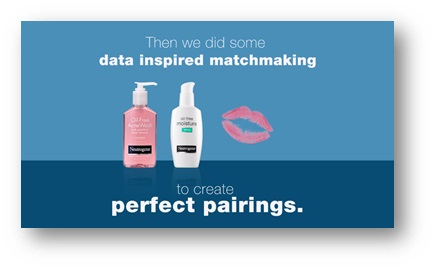Beauty brand Neutrogena used shopping basket data to identify competitor products loyal customers were already buying that were within their own range.

Case study summary
• Product pairings were delivered through video, banner ads and coupons to drive sampling
• Consumers were targeted based on their personal buying habits
• Ads were served using programmatic placements within online environments where the consumer would be in the right mindset to consider the message e.g. online beauty magazines.
• Saw an increase in incremental sales with £5.84 return on advertising spend (ROAS)
Challenge
• 75% of loyal customers were only buying products from one segment
• Brand wanted to drive sales of loyal customers and encourage non-Neutrogena users to try for the first time
Neutrogena knew they had a loyal base of customers, but 75% of shoppers were only buying items within a single segment of the Neutrogena range.
The brand wanted to drive sales amongst loyal purchasers by introducing them to new products in other segments, as well as recruit non-Neutrogena users to try their products for the first time.
Solution
• Used shopping basket data to create “perfect pairings” of products that naturally fit together (e.g. mascara and make up remover wipes)
• Used programmatic to target users based on buying habits
• Brand lovers and non-brand users alike were already using products that Neutrogena could supply
• Many beauty products fit together naturally as a pairing
With agency UM J3 and in partnership with Catalina, Neutrogena, used shopping basket data to identify competitor products loyal customers were already buying that were within their own range.
They also identified potential new buyers based on the similarities between their shopping baskets and the shopping baskets of loyal Neutrogena users.
The brand used these insights to create multiple pairings of products that perfectly complemented one another, and reflected consumer buying habits and usage needs, for example, Neutrogena mascara was shown in the creative alongside makeup removal wipes.
Creative was delivered through banner ads and videos and included product information and coupons to drive sampling.
Different product pairings were delivered to consumers based on their personal buying habits. These ads were served using programmatic placements within online environments where the consumer would be in the right mindset to consider the message e.g. online beauty magazines.
Key digital tools used
• Shopping basket data insights
• Addressable creative
• Programmatic media buying
• Digital coupons
Results
The campaign saw some impressive results and they exceeded their own benchmarks by 289%.
• Increase in incremental sales
• 18.1 million households reached
• 83 million impressions
• £5.84 return on advertising spend (ROAS)
Brand lovers and non-brand users alike were already using products that Neutrogena could supply. Many beauty products fit together naturally as a pairing.
The key to sales growth would be to make consumers aware that Neutrogena had products that were previously unfamiliar available within their range and encourage the purchase of the two products that naturally fit together as part of their regular beauty regime.
It is not a revolutionary or new approach, but it perfectly shows how consistently applying best practice and bringing together shopper insights, creative design, efficient media buying and planning pays off. £5.84 ROAS looks very reasonable and hopefully considering the consumer lifetime value it makes business sense for Neutrogena. We wish more brands would be so consistent with applying the “basics”. We would have better results for brands and more happy consumers.